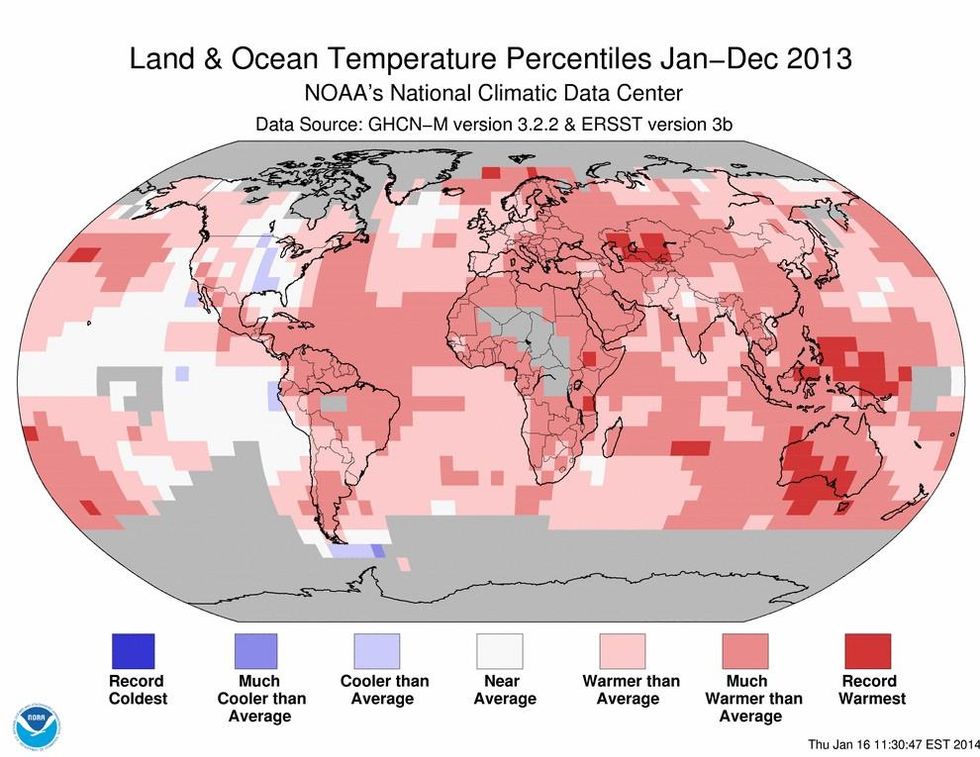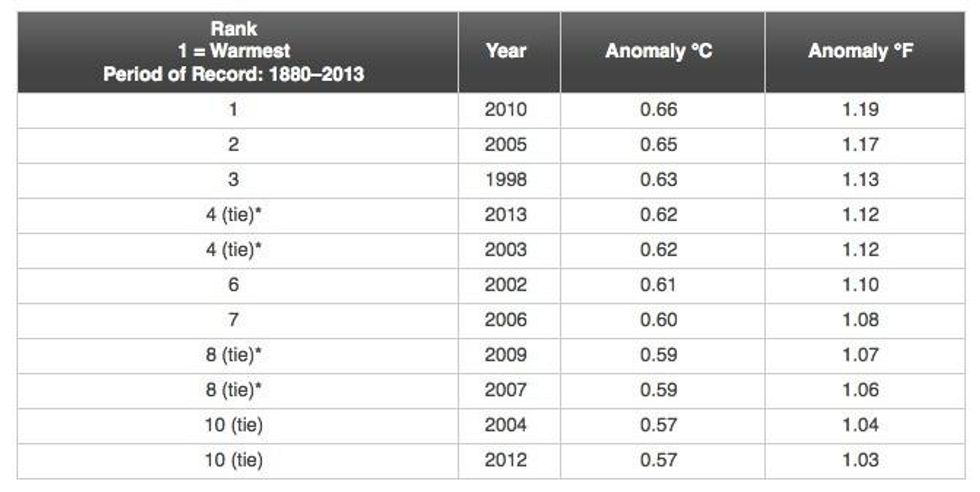More Evidence of Ongoing Climate Change
NOAA says 2013 is tied for fourth warmest year on record

The NOAA's National Climatic Data Center said on Tuesday that last year ties with 2003's ranking, and marks a continuation of a global warming trend.

According to calculations by NASA also released Tuesday, 2013 tied with 2009 and 2006 for the seventh warmest year since records began in 1880.
Both federal agencies agree that 9 of the 10 warmest years have happened since 2000.
"Long-term trends in surface temperatures are unusual and 2013 adds to the evidence for ongoing climate change," said climatologist Gavin Schmidt of NASA's Goddard Institute for Space Studies. "While one year or one season can be affected by random weather events, this analysis shows the necessity for continued, long-term monitoring."
A statement from NASA adds that "the level of carbon dioxide in Earth's atmosphere presently is higher than at any time in the last 800,000 years."
In 2013, the world also hit the "sobering milestone" of 400 parts per million (ppm) of CO2 --a first in human history. "It feels like the inevitable march toward disaster," Maureen E. Raymo, a Columbia University earth scientist, said of hitting the 400 mark.
In one possible emissions scenario, one in which "people pursue personal wealth rather than environmental quality" and current emissions trajectories continue, the world could reach 1,000 ppm in one hundred years.
__________________
An Urgent Message From Our Co-Founder
Dear Common Dreams reader, The U.S. is on a fast track to authoritarianism like nothing I've ever seen. Meanwhile, corporate news outlets are utterly capitulating to Trump, twisting their coverage to avoid drawing his ire while lining up to stuff cash in his pockets. That's why I believe that Common Dreams is doing the best and most consequential reporting that we've ever done. Our small but mighty team is a progressive reporting powerhouse, covering the news every day that the corporate media never will. Our mission has always been simple: To inform. To inspire. And to ignite change for the common good. Now here's the key piece that I want all our readers to understand: None of this would be possible without your financial support. That's not just some fundraising cliche. It's the absolute and literal truth. We don't accept corporate advertising and never will. We don't have a paywall because we don't think people should be blocked from critical news based on their ability to pay. Everything we do is funded by the donations of readers like you. Will you donate now to help power the nonprofit, independent reporting of Common Dreams? Thank you for being a vital member of our community. Together, we can keep independent journalism alive when it’s needed most. - Craig Brown, Co-founder |

The NOAA's National Climatic Data Center said on Tuesday that last year ties with 2003's ranking, and marks a continuation of a global warming trend.

According to calculations by NASA also released Tuesday, 2013 tied with 2009 and 2006 for the seventh warmest year since records began in 1880.
Both federal agencies agree that 9 of the 10 warmest years have happened since 2000.
"Long-term trends in surface temperatures are unusual and 2013 adds to the evidence for ongoing climate change," said climatologist Gavin Schmidt of NASA's Goddard Institute for Space Studies. "While one year or one season can be affected by random weather events, this analysis shows the necessity for continued, long-term monitoring."
A statement from NASA adds that "the level of carbon dioxide in Earth's atmosphere presently is higher than at any time in the last 800,000 years."
In 2013, the world also hit the "sobering milestone" of 400 parts per million (ppm) of CO2 --a first in human history. "It feels like the inevitable march toward disaster," Maureen E. Raymo, a Columbia University earth scientist, said of hitting the 400 mark.
In one possible emissions scenario, one in which "people pursue personal wealth rather than environmental quality" and current emissions trajectories continue, the world could reach 1,000 ppm in one hundred years.
__________________

The NOAA's National Climatic Data Center said on Tuesday that last year ties with 2003's ranking, and marks a continuation of a global warming trend.

According to calculations by NASA also released Tuesday, 2013 tied with 2009 and 2006 for the seventh warmest year since records began in 1880.
Both federal agencies agree that 9 of the 10 warmest years have happened since 2000.
"Long-term trends in surface temperatures are unusual and 2013 adds to the evidence for ongoing climate change," said climatologist Gavin Schmidt of NASA's Goddard Institute for Space Studies. "While one year or one season can be affected by random weather events, this analysis shows the necessity for continued, long-term monitoring."
A statement from NASA adds that "the level of carbon dioxide in Earth's atmosphere presently is higher than at any time in the last 800,000 years."
In 2013, the world also hit the "sobering milestone" of 400 parts per million (ppm) of CO2 --a first in human history. "It feels like the inevitable march toward disaster," Maureen E. Raymo, a Columbia University earth scientist, said of hitting the 400 mark.
In one possible emissions scenario, one in which "people pursue personal wealth rather than environmental quality" and current emissions trajectories continue, the world could reach 1,000 ppm in one hundred years.
__________________

